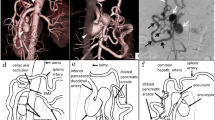Abstract
The purpose of this study was to assess the efficacy of transcatheter arterial embolization for ruptured pancreaticoduodenal artery (PDA) aneurysms associated with celiac axis stenosis (CS). Seven patients (four men and three women; mean age, 64; range, 43–84) were treated with transcatheter arterial embolization between 2002 and 2007. They were analyzed with regard to the clinical presentation, radiological finding, procedure, and outcome. All patients presented with sudden epigastric pain or abdominal discomfort. Contrast-enhanced CT showed a small aneurysm and retroperitoneal hematoma around the pancreatic head in all patients. The aneurysms ranged from 0.3 to 0.9 cm in size. In one patient, two aneurysms were detected. The aneurysms were located in the pancreaticoduodenal artery (n = 5) and the dorsal pancreatic artery (n = 3). Embolization was performed with microcoils in all aneurysms (n = 8). N-Butyl 2-cyanoacrylate (n = 1) and gelatine particle (n = 1) were also used. Complete occlusion was achieved in four patients. In the other three patients, a significantly reduced flow to the aneurysm remained at final angiography. However, these aneurysms were thrombosed on follow-up CT within 2 weeks. And there was no recurrence of the symptoms and bleeding during follow-up (mean, 28 months; range, 5–65 months) in all patients. In conclusion, transcatheter arterial embolization for PDA aneurysms associated with CS is effective. Significant reduction of the flow to the aneurysm at final angiography may be predictive of future thrombosis.



Similar content being viewed by others
References
Stanley JC, Wakefield TW, Graham LM et al (1986) Clinical importance and management of splanchnic artery aneurysms. J Vasc Surg 3:836–840
Neschis DG, Safford SD, Golden MA (1998) Management of pancreaticoduodenal artery aneurysms presenting as catastrophic intraabdominal bleeding. Surgery 123:8–12
Mandel SR, Jaques PF, Mauro MA et al (1987) Nonoperative management of peripancreatic arterial aneurysms. Ann Surg 205:126–128
Perrot MD, Berney T, Deleaval J et al (1999) Management of true aneurysms of the pancreaticoduodenal arteries. Ann Surg 229:416–420
Murata S, Tajima H, Fukunaga T et al (2006) Management of pancreaticoduodenal artery aneurysms: results of superselective transcatheter embolization. AJR 187:290–298
Weber CH, Pfeifer KJ, Tato F et al (2005) Transcatheter coil embolization of an aneurysm of the pancreatico-duodenal artery with occluded celiac trunk. CardioVasc Interv Radiol 28:259–261
Uher P, Nyman U, Ivancev K et al (1995) Aneurysms of the pancreaticoduodenal artery associated with occlusion of the celiac artery. Abdom Imaging 20:470–473
Jibiki M, Inoue Y, Iwai T et al (2005) Treatment of three pancreaticoduodenal artery aneurysms associated with coeliac artery occlusion and splenic artery aneurysm: a case report and review of the literature. Eur J Vasc Endovasc Surg 29:213–217
Ogino H, Sato Y, Banno T et al (2002) Embolization in a patient with ruptured anterior inferior pancreaticoduodenal arterial aneurysm with median arcuate ligament syndrome. CardioVasc Interv Radiol 25:318–319
Guijt M, van Delden OM, Koedam NA et al (2004) Rupture of true aneurysms of the pancreaticoduodenal arcade: treatment with transcatheter arterial embolization. CardioVasc Interv Radiol 27:166–169
Kobayashi T, Uenoyama S, Isogai S (2004) Successful transcatheter arterial embolization of an inferior pancreaticoduodenal artery aneurysm associated with celiac axis stenosis. J Gastroenterol Hepatol 19:599–601
Ikeda O, Tamura Y, Nakasone Y et al (2007) Coil embolization of pancreaticoduodenal artery anewurysms associated with celiac artery stenosis: report of three cases. CardioVasc Interv Radiol 30:504–507
Patten RM, Coldwell DM, Ben-Menachem Y (1990) Ligamentous compression of the celiac axis: CT findings in five patients. AJR 156:1101–1103
Horton KM, Talamini MA, Fishman EK (2005) Median arcuate ligament syndrome: evaluation with CT angiography. Radio Graphics 25:1177–1182
Suton D, Lawton G (1973) Celiac stenosis or occlusion with aneurysm of the collateral supply. Clin Radiol 24:49–53
Bron KM, Redman HC (1969) Splanchnic artery stenosis and occlusion: incidence, arteriographic and clinical manifestations. Radiology 92:323–328
Park CM, Chung JW, Kim HB et al (2001) Celiac axis stenosis: incidence and etioloties in asymptomatic individuals. Korean J Radiol 2:8–13
Iyomasa S, Matsutaka Y, Hiei K et al (1995) Pancreaticoduodenal artery aneurysm: a case report and revies of the literature. J Vasc Surg 22:161–166
Bageacu S, Cuilleron M, Kaczmarek D et al (2006) True aneurysms of the pancreaticoduodenal artery: successful non-operative management. Surgery 139:608–616
Tien YW, Kao HL, Wang HP (2004) Celiac artery stenting: a new strategy for patients with pancreaticoduodenal artery aneurysm associated with stenosis of the celiac artery. J Gastroenterol 39:81–85
Proud G, Chamberlain J (1978) Aneurysm formation on the small pancreatic arteries in associated with celiac axis compression. Ann R Coll Surg Engl 60:294–297
Suzuki K, Kashimura H, Sato M et al (1998) Pancreaticoduodenal artery aneurysms associated with celiac axis stenosis due to compression by median arcuate ligament and celiac plexus. J Gastroenterol 33:434–438
Quandalle P, Chambon JP, Marache P et al (1990) Pancreaticoduodenal artery aneurysms associated with celiac axis stenosis: report of two cases and review of the literature. Ann Vasc Surg 4:540–545
Ducasse E, Roy F, Chevalier J et al (2004) Aneurysm of the pancreaticoduodenal arteries with a celiac trunk lesion: current management. J Vasc Surg 39:906–911
Author information
Authors and Affiliations
Corresponding author
Rights and permissions
About this article
Cite this article
Suzuki, K., Tachi, Y., Ito, S. et al. Endovascular Management of Ruptured Pancreaticoduodenal Artery Aneurysms Associated with Celiac Axis Stenosis. Cardiovasc Intervent Radiol 31, 1082–1087 (2008). https://doi.org/10.1007/s00270-008-9343-3
Received:
Revised:
Accepted:
Published:
Issue Date:
DOI: https://doi.org/10.1007/s00270-008-9343-3




